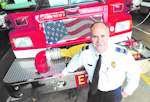Tech Support Introduction: Technology: Where We Are Now And Where We Are Going
Technology is playing an ever-increasing role in today’s emergency service community by enhancing of roles and responsibilities in the areas of effectiveness, fiscal responsibility and safety. This supplement is designed to increase the awareness of various technology opportunities that can help to increase organizational effectiveness and efficiency in the areas of administration/planning, operations, response, mitigation, recovery and safety. We cover technology that is presently in use, technology that is being transitioned into the public safety environment and a glimpse into the future.
The technologies that are discussed in this supplement include land mobile radios/portables and associated accessories and peripheral technologies, and commercial wireless broadband and related apps, accessories and mobile devices. See examples of how commercial wireless broadband provides affordable services, mobile devices and exciting new apps that ultimately can save organizations and localities thousands of dollars. We also provide a glimpse into the development of the nationwide public safety wireless broadband network – First Responder Network Authority (FirstNet).
It is an exciting time and it is even more important, necessary and exciting to be aware of the newest developments in land mobile systems, radios and portables, broadband networks/technology and opportunities; how they work in concert to enhance firefighter safety through a more effective public safety communications environment.
The article, “Technology Today and Tomorrow,” describes how tablets, smartphones and other mobile devices are transforming public safety communications. In “Land Mobile Radio Versus Broadband,” we discuss each technology in light of future emergency communications requirements, noting that while mission-critical voice may be achieved for broadband, until that time land mobile radio “remains the solid solution.” Finally, the article titled “What’s Next?” notes, “This is an exciting time when technology continues to change dramatically and provide capabilities that we would only have dreamed of several years ago.”
CHARLES WERNER, EFO/CFO, a Firehouse® contributing editor, is a 39-year veteran of the fire service and chief of the Charlottesville, VA, Fire Department. He serves on the Charlottesville Regional Emergency Communications Management Board, Virginia Statewide Interoperability Executive Committee, Virginia Secure Commonwealth Panel, Department of Homeland Security (DHS) SAFECOM Executive Committee, National Alliance for Public Safety GIS, National Information Sharing Consortium and International Association of Fire Chiefs (IAFC) Technology Council. He was recently appointed by DHS Secretary Janet Napolitano to the Homeland Security Information Network (HSIN) Advisory Committee. Werner is a past president of the Virginia Fire Chiefs Association.

Charles Werner
CHARLES WERNER, who is a Firehouse contributing editor, is a 45-year veteran of public safety. He served with the Charlottesville, VA, Fire Department for 37 years, serving the past 10 years as chief. Following retirement, Werner served for two years as senior adviser and acting deputy state coordinator for the Virginia Department of Emergency Management. He has chaired: DHS SAFECOM Executive Committee; IAFC Technology Council; National Information Sharing Consortium; and DHS/White House Incident Management Information Sharing SubCommittee. Werner currently serves as the director of DroneResponders Public Safety Alliance, chair of the National Council on Public Safety UAS and chair of the Virginia Secure Commonwealth UAS Sub Panel.






